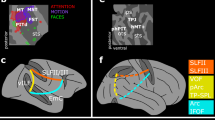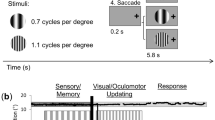Abstract
It is widely agreed that the right posterior parietal cortex has a preeminent role in visuospatial and orienting attention. A number of lines of evidence suggest that although orienting and the preparation of oculomotor responses are dissociable from each other, the two are intimately related. If this is true, then it should be possible to identify other attentional mechanisms tied to other response modalities. We used repetitive transcranial magnetic stimulation (rTMS) to demonstrate the existence of a distinct anterior parietal mechanism of motor attention. The critical area for motor attention is anterior to the one concerned with orienting, and it is lateralized to the left hemisphere in humans.
This is a preview of subscription content, access via your institution
Access options
Subscribe to this journal
Receive 12 print issues and online access
$209.00 per year
only $17.42 per issue
Buy this article
- Purchase on Springer Link
- Instant access to full article PDF
Prices may be subject to local taxes which are calculated during checkout



Similar content being viewed by others
References
Colby, C. L. & Goldberg, M. E. Space and attention in parietal cortex. Annu. Rev. Neurosci. 22, 319–349 (1999).
Corbetta, M., Miezin, F. M., Shulman, G. L. & Petersen, S. E. A PET study of visuospatial attention. J. Neurosci. 13, 1202–1226 (1993).
Nobre, A. C. et al. Functional localization of the system for visuospatial attention using positron emission tomography. Brain 120, 515–533 (1997).
Gitelman, D. R. et al. A large-scale distributed network for covert spatial attention: further anatomical delineation based on stringent behavioural and cognitive controls. Brain 122, 1093–1106 (1999).
Posner, M. I., Walker, J. A., Friedrich, F. J. & Rafal, R. D. Effects of parietal injury on covert orienting of attention. J. Neurosci. 4, 1863–1874 (1984).
Posner, M. I., Inhoff, A. W., Friedrich, F. J. & Cohen, A. Isolating attentional systems: a cognitive-anatomical analysis. Psychobiology 1, 107–121 (1987).
Sheliga, B. M., Riggio, L. & Rizzolatti, G. Spatial attention and eye movements. Exp. Brain Res. 105, 261–275 (1995).
Snyder, L. H., Batista, A. P. & Andersen, R. A. Coding of intention in the posterior parietal cortex. Nature 386, 167–170 (1997).
Corbetta, M. et al. A common network of functional areas for attention and eye movements. Neuron 21, 761–773 (1998).
Gottlieb, J. P., Kusonoki, M. & Goldberg, M. E. The representation of visual salience in monkey parietal cortex. Nature 391, 481–484 (1998).
Gottlieb, J. & Goldberg, M. E. Activity of neurons in the lateral intraparietal area of the monkey during an antisaccade task. Nat. Neurosci. 2, 906–912 (1999).
Cavada, C. & Goldman-Rakic, P. S. Posterior parietal cortex in rhesus monkey: I. Parcellation of areas based on distinctive limbic and sensory corticocortical connections. J. Comp. Neurol. 287, 393–421 (1989).
Cavada, C. & Goldman-Rakic, P. S. Posterior parietal cortex in rhesus monkey: II. Evidence for segregated corticocortical networks linking sensory and limbic areas with the frontal lobe. J. Comp. Neurol. 287, 422–445 (1989).
Paus, T. et al. Transcranial magnetic stimulation during positron emission tomography: a new method for studying connectivity of the human cerebral cortex. J. Neurosci. 17, 3178–3184 (1997).
Eidelburg, D. & Galaburda, A. M. Inferior parietal lobule: divergent architectonic asymmetries in the human brain. Arch. Neurol. 41, 843–852 (1984).
Von Bonin, G. & Bailey, P. The Neocortex of Macacca Mulatta (Univ. of Illinois Press, Urbana, Illinois, 1947).
Passingham, R. E. in Comparative Neuropsychology (ed. Milner, A. D.) 271–298 (Oxford Univ. Press, Oxford, 1998).
Rushworth, M. F. S., Nixon, P. D. & Passingham, R. E. Parietal cortex and movement. II. Spatial representations. Exp. Brain Res. 117, 311–323 (1997).
Rushworth, M. F. S., Johansen-Berg, H. & Young, S. A. Parietal cortex and spatial-postural transformation during arm movements. J. Neurophysiol. 79, 478–482 (1998).
Colby C. L., Duhamel, J. R. & Goldberg, M. E. Oculocentric spatial representation in parietal cortex. Cereb. Cortex 5, 470–481 (1995).
Duhamel, J. R., Bremmer, F., BenHamed, S. & Graf, W. Spatial invariance of visual receptive fields in parietal cortex neurons. Nature 389, 845–848 (1997).
Cracco, R. Q., Cracco, J. B., Maccabee, P. J. & Amassian, V. E. Cerebral function revealed by transcranial magnetic stimulation. J. Neurosci. Methods 86, 209–219 (1999).
Edgley, S. A., Eyre, J. A., Lemon, R. N. & Miller, S. Comparison of activation of corticospinal neurons and spinal motor neurons by magnetic and electrical stimulation in the lumbosacral cord of the anaesthetized monkey. Brain 120, 839–853 (1997).
Paus, T. et al. Dose-dependent reduction of cerebral blood flow during rapid-rate transcranial magnetic stimulation of the human sensorimotor cortex. J. Neurophysiol. 79, 1102–1107 (1998).
Walsh, V. & Cowey, A. Magnetic stimulation studies of visual cognition. Trends Cogn. Sci. 2, 103–110 (1998).
Walsh, V. & Rushworth, M. F. S. The use of transcranial magnetic stimulation in neuropsychological testing. Neuropsychologia 37, 125–135 (1999).
Pascual-Leone, A. et al. Induction of visual extinction by rapid-rate transcranial magnetic stimulation of parietal lobe. Neurology 44, 494–498 (1994).
Ashbridge, E., Walsh, V. & Cowey, A. Temporal aspects of visual search studied by transcranial magnetic stimulation. Neuropsychologia 35, 1121–1131 (1997).
Marzi, C. A. et al. Transcranial magnetic stimulation selectively impairs interhemispheric transfer of visuo-motor information in humans. Exp. Brain Res. 118, 435–438 (1998).
Walsh, V., Ellison, A., Battelli, L. & Cowey, A. Task-specific impairments and enhancements induced by magnetic stimulation of human visual area V5. Proc. R. Soc. Lond. B Biol. Sci. 265, 537–543 (1998).
Oliveri, M. et al. Left frontal transcranial magnetic stimulation reduces contralesional extinction in patients with unilateral right brain damage. Brain 122, 1731–1739 (1999).
Talairach, J. & Tournoux, P. Co-Planar Stereotaxic Atlas of the Human Brain (Thieme, Stuttgart, 1988).
Evans, A. C., Collins, D. L. & Holmes, C. J. in Brain Mapping: The Methods (eds. Toga, A. W. & Mazziotta, J. C.) 343–361 (Academic, San Diego, 1996).
Desmurget, M. et al. Role of the posterior parietal cortex in updating reaching movements to a visual target. Nat. Neurosci. 2, 563–567 (1999).
Pisella, L. et al. An 'automatic pilot' for the hand in human posterior parietal cortex: toward reinterpreting optic ataxia. Nat. Neurosci. 3, 729–736 (2000).
Corbetta, M., Kincade, J. M., Ollinger, J. M., McAvoy, M. P. & Shulman, G. L. Voluntary orienting is dissociated from target detection in human posterior parietal cortex. Nat. Neurosci. 3, 292–297 (2000).
Rushworth, M. F. S., Krams, M. & Passingham, R. E. The attentional role of the left parietal cortex: the distinct lateralization and localization of motor attention in the human brain. J. Cogn. Neurosci. (in press).
Deiber, M.-P., Ibanez, V., Sadato, N. & Hallet, M. Cerebral structures participating in motor preparation in humans: a positron emission tomography study. J. Neurophysiol. 75, 233–247 (1996).
Steinmetz, M. A. & Constantinidis, C. Neurophysiological evidence for a role of posterior parietal cortex in redirecting visual attention. Cereb. Cortex 5, 448–456 (1995).
Robinson, C. J. & Burton, H. Organization of somatosensory receptive fields in cortical areas 7b, retroinsula, postauditory and granular insula of M. fascicularis. J. Comp. Neurol. 192, 69–92 (1980).
Sakata, H. et al. Neural representation of three-dimensional features of manipulation objects with stereopsis. Exp. Brain Res. 128, 160–169 (1999).
Ferraina, S. et al. Combination of hand and gaze signals during reaching: activity in parietal area 7m of the monkey. J. Neurophysiol. 77, 1034–1038 (1997).
Walsh, V., Ellison, A., Ashbridge, E. & Cowey, A. The role of the parietal cortex in visual attention–hemispheric asymmetries and the effects of learning: a magnetic stimulation study. Neuropsychologia 37, 245–251 (1999).
Wittelson, S. F. & Kigar, D. L. Sylvian fissure morphology and asymmetry in men and women: bilateral differences in relation to handedness in men. J. Comp. Neurol. 323, 326–340 (1992).
Rushworth, M. F. S., Nixon, P. D., Renowden S., Wade, D. T. & Passingham, R. E. The left parietal cortex and attention to action. Neuropsychologia 35, 1261–1273 (1997).
Duhamel, J. R., Colby, C. L. & Goldberg, M. E. The updating of the representation of visual space in parietal cortex by intended eye movements. Science 255, 90–92 (1992).
Duhamel, J. R., Goldberg, M. E., Fitzgibbon, E. J., Sirigu, A. & Grafman, J. Saccadic dysmetria in a patient with a right frontoparietal lesion. The importance of corollary discharge for accurate spatial behaviour. Brain 115, 1387–1402 (1992).
Wassermann E. M. Risk and safety of repetitive transcranial magnetic stimulation: report and suggested guidelines from the international workshop on the safety of repetitive transcranial magnetic stimulation, June 5–7, 1996. Electroenceph. Clin. Neurophysiol. 198, 1–16 (1998).
Schluter, N., Rushworth, M. F. S., Nixon, P. D., Mills, K. & Passingham, R. E. Temporary inteference in human lateral premotor cortex suggests dominance for the selection of movements: a study using transcranial magnetic stimulation. Brain 121, 785–799 (1998).
Ruohonen, J. R. & Ilmoniemi, J. Modelling of the stimulating field generation in TMS. Electroenceph. Clin. Neurophysiol. Suppl. 51, 30–40 (1999).
Acknowledgements
Supported by the Royal Society, the Dr. Hadwen Trust, and the Medical Research Council.
Author information
Authors and Affiliations
Corresponding author
Rights and permissions
About this article
Cite this article
Rushworth, M., Ellison, A. & Walsh, V. Complementary localization and lateralization of orienting and motor attention. Nat Neurosci 4, 656–661 (2001). https://doi.org/10.1038/88492
Received:
Accepted:
Issue Date:
DOI: https://doi.org/10.1038/88492
This article is cited by
-
Precise motor mapping with transcranial magnetic stimulation
Nature Protocols (2023)
-
Cross-hemispheric recruitment during action planning with increasing task demand
Scientific Reports (2023)
-
Hemispheric Asymmetry in TMS-Induced Effects on Spatial Attention: A Meta-Analysis
Neuropsychology Review (2023)
-
Causal involvement of the left angular gyrus in higher functions as revealed by transcranial magnetic stimulation: a systematic review
Brain Structure and Function (2023)
-
A distributed theta network of error generation and processing in aging
Cognitive Neurodynamics (2023)



